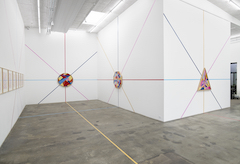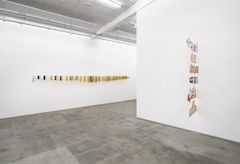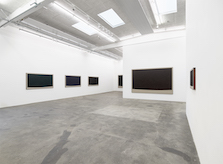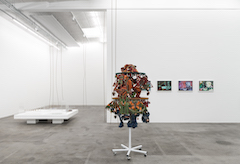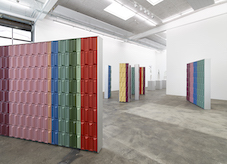We are pleased to present the group exhibition BETAMAX with works by Charlotte Brüel, Rebecca Lindsmyr, Iulia Nistor, Lea Porsager, Sonia Landy Sheridan, Tove Storch and Haegue Yang.
BETAMAX
The exhibition title Betamax is a reference to Sony’s 12.7 mm home-video-tape format launched in 1975. The name is derived from the tape’s drive mechanism, which resembles the Greek letter beta. In spite of several superior attributes, including a better-quality picture, it was nevertheless outpaced by the VHS system on the global market. At present, the VHS- and Betamax formats are a thing of the past, for younger generations perhaps just words without body. Words that have disappeared from our language, replaced by new standards for digital representation such as JPEG or NFT. In an etymological sense, the word ’technology’ is made up of téchnë, Greek for arts and craft, and lógos, meaning thought and reason. Technology has since become truly distanced from its original meaning and assumed an almighty and, at times, inhumane character.
“Consciousness constantly creates new things, coloured by what came before and what will be, a constant process, the very phenomenon of creating states of consciousness – that is time. Existing in time, therefore, means being in a state of creation in a heterogeneous, continual stream of ‘has been, is, and will become’.”[1]
The ethos of art is non-linear – like our perception of time. The exhibition presents seven different practices which, collectively, extend across four generations. With their individual experience, they represent different contemporary impressions. Traces intersecting across media. It is a coincidence which, like non-representative painting, is never an upshot of chance but rather a result of stored movements and patterns of perception, operating among several kinds of consciousness.
It is a psychological and physical algorithm used to create, examine, and solve problems during the creational process. Like the camera-based works in the exhibition, it is the actual process behind the picture that brings about the final result. We are presented with manipulative surveillance shots copied from the screen like an analogous screenshot. Works with an inbuilt vacuum of forty years – studies in early digital image experiments which cannot be relegated to a specific time frame, since the works’ creational process spans four decades.
The idea of a room for continuous creative activities is continued in sculptures whose narrative appears open, exact, and unfinished – a network where several spaces come together as one. The exhibition generates a complex network, in which the large installations are shaped by objects subjected to physical cumulative reduction and a redistribution of energy – from colossal vertical connecting links between heaven and earth to openings uniting nature and civilisation. Individually, several works try to unite industrial material and various kinds of arts and craft. Details are not sublime but essential parts of the whole – and, at the same time, the whole is embedded in each separate detail. Together, the works in the exhibition represent a collective pattern of movement, pointing back, forward and sideways.
’Generation loss’ might be interpreted as a generation of people who have lost something. Originally, it is a technical term denoting a cumulative loss of quality arising when copies of copies are made over time. Man’s genetic material is the result of replication, ensuring a stable passing-on of DNA from one generation to the next. Like the chromosomes in our cells, human culture has to be passed on. The DNA of our different cultures is structured by rituals, often appearing so heterogeneous in its form that it seems to surpass our own biology in complexity.[2] In light of the passing on of culture, ’generation loss’ might, on the contrary, evoke artistic value; each repetition serves to further inform the idiom. The minor deviations or displacements possibly resulting from repetition will form a basis for new experience. One is tempted to ask whether repetition exists, at all – or whether it is solely insistence on development?
“Body: it is a world-building word, filled with potential, and, as with glitch, filled with movement. Bodied, when used as a verb, is defined in the Oxford Dictionary as “giving material form to something abstract”.”[3]
/ Laura Goldschmidt
[1] Anne Fastrup: At vare – om tiden og bevidstheden hos Henri Bergson, 1989, pp. 19–20.
[2] Den Danske Radeerforening. Medlemsnyt, May 2020 by Andreas Albrectsen: ‘LA Air – Jonathan Monk’.
[3] Legacy Russell: Glitch Feminism. A Manifesto, (Glitch is Cosmic), 2020, pp. 41–42.
BETAMAX
Udstillingstitlen Betamax kommer fra Sonys 12,7 mm hjemmevideobåndformat, der blev lanceret i 1975. Navnet kommer af videobåndets løbeværk, der ligner det græske bogstav beta. På trods af flere fordele som fx bedre billedkvalitet blev det alligevel udkonkurreret af VHS-systemet på det globale marked. I dag tilhører VHS- og Betamax-formaterne en svunden tid, der for yngre generationer måske blot eksisterer som ord uden krop. Ord der er gledet ud af sproget og erstattet af nye standarder for digital repræsentation som JPEG eller NFT. Etymologisk set er ordet ’teknologi’ sammensat af téchnë, græsk for kunst og håndværk, og lógos, der betyder tanke og fornuft. Siden hen har teknologien i den grad bevæget sig væk fra sine oprindelige betydningsnuancer og påtaget sig en almægtig og til tider inhuman karakter.
”Det at bevidstheden hele tiden frembringer noget nyt, der er farvet af det, som det lige har været og straks skal blive, den evige forløben, selve fænomenet tilblivelsen af bevidsthedstilstande, dét er tiden. At være i tiden vil derfor sige at være tilblivende i en heterogen, kontinuerlig strøm af ’har været, er, vil blive’.”[1]
Kunstens væsen er nonlineær – ligesom vores tidsopfattelse. I udstillingen præsenteres syv forskellige praksisser, der sammenlagt strækker sig over fire generationer. Med deres individuelt funderede erfaringsgrundlag repræsenterer de forskellige aftryk i samtiden. Spor der krydser hinanden på tværs af medier. Det er et sammentræf, der, ligesom det nonrepræsentative maleri, aldrig er et resultat af tilfældigheder, men derimod af lagrede bevægelser og forståelsesmønstre, der opererer mellem flere bevidstheder.
Det er en psykologisk og fysisk algoritme, som benyttes til at skabe, undersøge og løse problemstillinger i skabelsesprocessen. På samme måde som i de kamerabaserede værker på udstillingen er det selve processen bag billedet, der udgør det endelige resultat. Vi præsenteres her for manipulerede overvågningsbilleder, som er blevet affotograferet fra skærmen som et analogt screenshot. Det er værker med et indbygget vakuum på 40 år – studier i tidlig digital billedeksperimentering, der dog ikke umiddelbart kan sættes ind i en specifik tidsramme, da værkernes tilblivelsesproces strækker sig over fire årtier.
Ideen om et kontinuerligt udfoldelsesrum fortsættes i skulpturer, der fremstår både åbne, eksakte og uafsluttede i deres fortælling – et netværk, der samler flere rumligheder i én. Udstillingen former et sammensat netværk, hvori de større installationer dannes af objekter, som har gennemgået en fysisk kumulativ reduktion og redistribuering af energi – fra kolossale vertikale bindeled mellem himmel og jord til åbninger, der forener naturen med civilisationen. Flere af værkerne arbejder på individuel vis med foreningen af industrielt materiale og forskellige former for håndværk. Detaljen er ikke ophøjet, men er derimod essentiel for helheden – og helheden ligger samtidig i hver enkelt detalje. I fællesskab danner udstillingens værker et samlet bevægelsesmønster, der tidsmæssigt peger både bagud, fremad og sidelæns.
Et ’generationstab’ kan umiddelbart forstås som et udtryk for en årgang af mennesker, der har mistet noget. Oprindeligt er der dog tale om en teknisk betegnelse for en kumulativ forringelse af kvalitet, der opstår, når en kopi gentages over tid. Menneskets genetiske arvemateriale er resultatet af replikation, der på den måde sikrer dna’ets stabile videreførelse fra generation til generation. Ligesom kromosomerne i vores celler er menneskets kultur baseret på videreførelse. Vores forskellige kulturers dna er opbygget af ritualer og fremstår ofte så heterogen i sin form, at den synes at overgå̊ vores egen biologi i kompleksitet.[2] I lyset af kulturens videreførelse kan ’generationstabet’ tværtimod fremmane en kunstnerisk værdi; for ved hver gentagelse bliver formsproget mere informeret. Og de små afvigelser eller forskydninger, gentagelsen måtte medføre, danner grobund for ny erfaring. Man fristes til at spørge, om gentagelsen overhovedet findes – eller om der udelukkende er tale om insisteren på udvikling?
“Body: it is a world-building word, filled with potential, and, as with glitch, filled with movement. Bodied, when used as a verb, is defined in the Oxford Dictionary as ‘giving material form to something abstract’.”[3]
/ Laura Goldschmidt
[1] Anne Fastrup: At vare – om tiden og bevidstheden hos Henri Bergson, 1989, p. 19-20.
[2] Den Danske Radeerforening. Medlemsnyt, Maj 2020 ved Andreas Albrectsen: ”LA AIR – Jonathan Monk”.
[3] Legacy Russell: Glitch Feminism. A Manifesto, (Glitch is Cosmic), 2020, p. 41-42.




